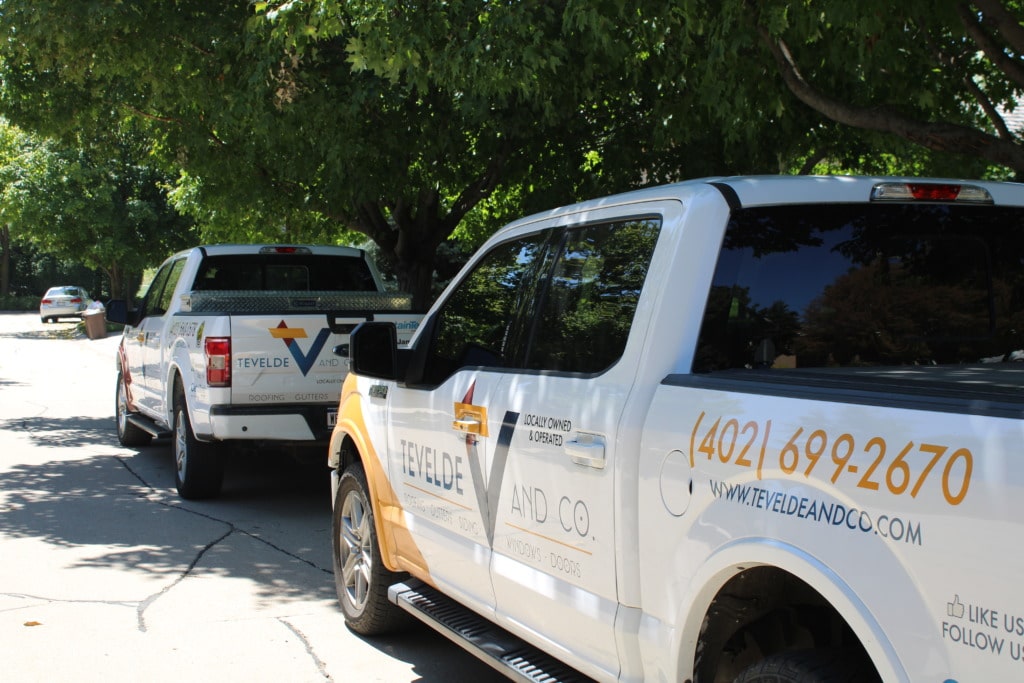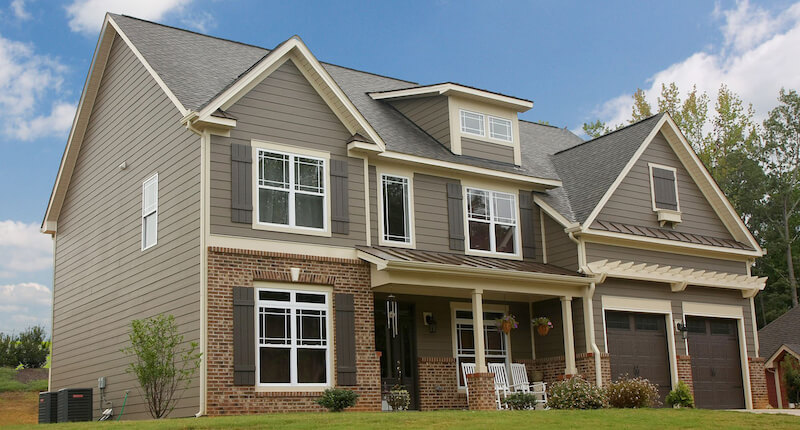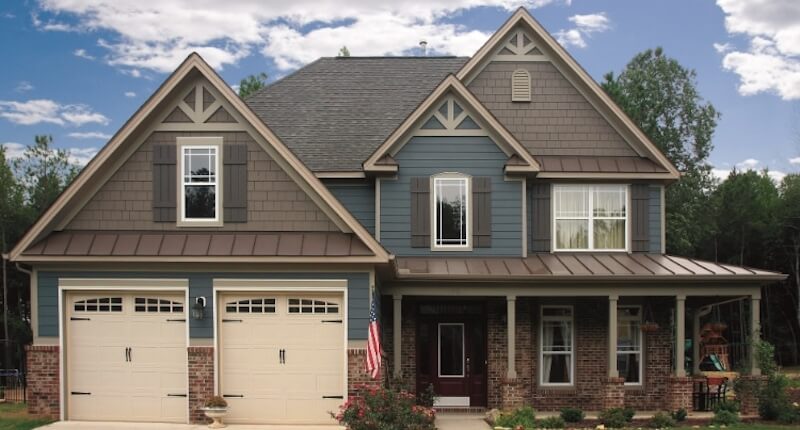A Guide to Low Slope Roofing
Low-slope roofing is known for its use on commercial properties throughout the United States; however, there are many homeowners across the country who have also taken advantage of the variety of benefits that this type of roofing style can offer!
Whether you’re the owner of a commercial building and want to know more about your roof or you’re considering upgrading your home’s roof, our guide to low slope roofing will help you identify what benefits low slope roofs have over their pitched counterparts, as well as what materials and flat roof styles are the best fit for your property. Read on to learn more, or contact Tevelde and Co. today for a free estimate!
Home / Roofing / Low Slope Roofing
What is a Low Slope Roof?
To understand the definition of a low slope roof, we first have to define roof pitch. Roof pitches are made from two numbers: the number of inches it rises vertically over the number of inches it extends horizontally. Both of these numbers are given on a scale of 12 inches. That means that a roof with a 4:12 pitch rises 4 inches for every 12 inches it extends.
Low slope roofs are defined as a roof with less than a 2:12 ratio. They’re mostly found on commercial properties in the form of metal roofs or rubber-based membranes, though more and more homeowners are making the switch or having homes built from the ground up with flat roofing in mind to take advantage of its many benefits.
Flat and Low-Slope Roofing are Common for Commercial Properties
When most people think of flat roofs, they likely picture the metal roofs commonly found on warehouses and other industrial or commercial buildings, and for good reason. Most commercial roofs, both in the United States and across the world, are flat roofing systems that can help their owners get the most possible utility out of their property. Flat roofs offer distinct advantages for commercial use, which we’ll get into later in this guide.
- What is Low Slope Roofing?
- Different Kinds of Flat Roofing Systems
- EPDM
- Single-Ply Membrane Roofing
- BUR
- TPO
- PVC
- Benefits of Installing Low Slope Roofing
- Energy Efficiency
- Quick Installations
- Extra Space for HVAC Equipment
- Are There Drawbacks for Low Slope Roofing?
- Tevelde and Co.’s Trusted Roofing Contractors

What are the Different Kinds of Flat Roofing Systems?
Whether you’re installing a roof on a commercial or residential property, when it comes to selecting a flat roofing system for your building, it’s important to choose the right material that matches your needs. When it comes to flat roofs, there’s no one-size-fits-all solution. Each type of flat roofing material offers a unique advantage compared to the others; for example, metal roofing is more fire-resistant than EPDM roofing, and TPO has fewer seams than BUR systems, resulting in a more water- and leak-free solution. Read on to learn more about the pros and cons of each of the major materials and styles used in flat roofing.
EPDM
Compared to other flat roofing materials, EPDM (Ethylene Propylene Diene Monomer) roofing is one of the most value-packed options. EPDM roofs are, like other kinds of membrane roofs, made from a single layer of rubber that is applied over the entire roofing deck. Primarily available in black, EPDM comes in at a competitive price point with other options on this list. It offers excellent resistance to high winds, has fewer seams than a BUR roof, and is great for complicated roof structures that have a lot of penetrations and walls.
EPDM typically comes in black, which absorbs heat and can contribute to higher energy costs during the summer. While white EPDM is available, it may be more expensive and prone to dirt accumulation. It is also a system where the seams are glued together, which is not as efficient as the heat-weld system you get with TPO.
Single-Ply Membrane Roof
Single-ply membrane roofing is a term that refers to a method of flat roofing where you only have one layer of waterproofing materail, compared to a BUR roof that has multiple layers. Single-ply membranes only use one layer of a rubber-based membrane over the insulation and the roof deck below. Single-ply roofing is simple to install and offers a lightweight, flexible covering at an affordable cost. The most common single-ply roofing materials are TPO, PVC, and EPDM.
BUR (Built-Up Roofing)
Out of the options we’ve covered so far, built-up roofs (also known as BUR membranes) are the most common among homeowners. They offer a durable, long-lasting source to waterproof flat roof portions of your home. Built-up roof membranes, which include modified bitumen roofs, are made up of multiple dense layers of tar, asphalt, gravel, and felt. These materials give the roof membrane incredible strength and durability, along with the ability to match the color of your sloping roof. They come in a variety of colors so that you can match the shingles on your home.
BUR roofs are also relatively easy to repair and offer energy-efficient product lines that offer UV resistance and an energy star rating. The primary drawback of BUR roofs is that they are installed with a seam every 3 feet, making them more susceptible to installation errors compared to a single-ply roof. They can also be installed with either a 10- or 20-year installation system, which, if you’re not clear on which version you’re having installed, might surprise you when you need it replaced sooner rather than later.
TPO
TPO (thermoplastic polyolefin) roofs are relatively new to the industry, though they’ve seen a significant jump in popularity over the last decade. This type of roofing is a single-ply membrane roofing system in that it is a single-layered membrane that is applied directly over the surface. TPO can be installed directly over existing materials or concrete using their fleece-back product line, or it can be installed in the traditional way over insulation boards. Where TPO stands out is how the seams are heat welded together, making a watertight seal across all seams and flashing. This is a significant advantage over other flat roofing products. TPO is purpose-built to reflect ultraviolet light and improve your energy savings and overall efficiency, even when compared to other flat roof types.
PVC
PVC roofing (polyvinyl chloride) offers a compelling combination of durability, functionality, and longevity for flat roofs, particularly those like porches and balconies that experience regular foot traffic. Unlike some other flat roof materials, PVC is specifically designed to withstand foot traffic without puncturing or tearing easily. However, this added durability comes at a price: PVC roofs tend to be more expensive than some alternative materials.
Another advantage of PVC is its use of heat-welded seams. This method creates an incredibly strong and watertight seal, minimizing the risk of leaks, a major concern for flat roofs. With a lifespan that can reach up to 20 years, a properly installed PVC roof offers excellent value over time. So, if you prioritize a durable, walkable surface for your porch or balcony and are willing to invest in long-term performance, PVC roofing material is the way to go.

What are the Benefits of Installing Low Slope Roofing Systems?
As we’ve seen so far, low-slope roofing offers a wide variety of benefits, depending on the specific system you choose. In addition to the improved durability and lifespan, low-slope roofing is perfect for most commercial properties due to its improved energy efficiency, ease and speed of installation and repair, and capacity for additional features that can specifically address your property’s needs.
Improved Energy Efficiency
Whether you opt for TPO, EPDM, or a BUR roof system, most flat roofing material manufacturers offer an energy-efficient version of their products, including some that come with energy star ratings. By reflecting or absorbing UV light more efficiently, these roofing materials can reduce the amount of heat that enters or leaves your building, helping to maintain a steadier climate and cutting back on the load that your climate control systems have to deal with. This translates directly to lower monthly energy costs and a more comfortable operating environment!
Maintenance and Prolonged Lifespan
One of the biggest advantages of flat roofs is their ease of maintenance. Unlike pitched roofs that require special equipment or professional help to navigate, flat roofs are easily accessible. This allows you to regularly clear away debris like leaves and branches that can trap moisture and lead to problems. Regular inspections become a breeze, allowing you to identify minor tears, loose seams, or even spot potential issues before they escalate. Additionally, with flat roofs, you can apply protective coatings that prolong the life of the material. This proactive maintenance, made easier by the flat roof’s design, goes a long way in protecting the material from harsh weather elements and extending the overall lifespan of your roof.
Extra Space for HVAC Units and Other Building Needs
One of the primary reasons commercial buildings invest in flat roofing is its ability to provide extra space for additional rooftop equipment or other specialized needs. A flat roof slope allows more space for the installation of HVAC equipment, skylights, ventilation systems, roof-mounted cranes for material delivery, and more.

Are There Drawbacks to Flat Roofing?
While flat roofing is an excellent – and preferred – roofing system for most commercial buildings, there are still a few drawbacks to be aware of before you make the investment. Aside from the individual drawbacks unique to each type of flat roofing material, there are a few general downsides that apply to nearly every type of flat roofing system.
Accounting for Drainage on a Low Slope Roof
A major benefit of sloped roofing is improved water drainage; when water hits the roof, it naturally runs down the slope and into the gutter system. With a flat roof, there is a potential for areas of poor drainage and water pooling, which can damage the membrane over time and lead to water intrusion via leaks, both large and small. This dynamic makes it very important to have a slope added to your roof via tappered insulation boards. This will allow you to direct the water towards the drains and eliminate ponding water.
Debris Build-Up Can Be an Issue
Debris can also pose an issue for flat roofs – for the same reasons as water runoff. On a sloped roof, storm debris, leaves, and dirt will naturally run down and into the gutters; on a flat roof system, debris tends to stay where it falls or, at best, move around on the roof’s surface.
Over time, debris buildup can cause issues both with water drainage and to the membranes themselves, especially when storms blow the debris across the roofing material again and again. Regular maintenance and cleaning can help mitigate this issue, but it’s something to be aware of over the years.

Tevelde and Co. is a Top-Rated Contractor for Low Slope and Flat Roofing Projects
If you’re in the market for flat roof installation, replacement, or repair, look no further than our team at Tevelde and Co.! We are extremely proud to be among Omaha’s top-rated roofing contractors. Our team uses proven methods and trusted materials to provide unmatched value, undeniable results, and best-in-class customer service from our initial consultation to the final sign-off!
Trusted and Professional Solutions for Flat Roofs
With over a decade of experience serving our local community, Tevelde and Co.’s top-rated team of industry professionals is ready to take on your next flat roofing project. We offer comprehensive installation, replacement, and repair services for all of the primary types of flat roofing, from EPDM to TPO and more. Our experts can help you identify which kind of flat roofing will provide the best value for your investment and help at every stage of the design, planning, and installation process.
We Offer a Wide Array of Roofing and Exterior Solutions
Our comprehensive commercial and residential solutions include flat and sloped roofing, along with other exterior services for siding, gutters, windows, and more. Read more about our full suite of property solutions here.
Article Updated: 6/19/24 | Published: 6/19/24
About The Author: Todd Tevelde
Todd Tevelde wrote this helpful guide about low slope roofing to help educate property owners in Omaha about their options for roofing systems. Todd is an expert in exterior renovations and the founder of Tevelde and Co. With over 10 years of experience helping homeowners, Tevelde and Co. has become one of the most trusted contractors in the greater Omaha area. For more information contact Tevelde and Co. today!
Financing Is Available.
Sometimes Home Remodeling projects can’t wait, or you just want to make all your updates at once. Get the financing you need with approved credit and check out our special offers to make the most of your home remodeling dollars.


 Window Services
Window Services






